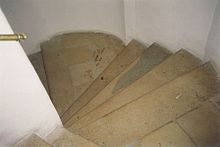Palace of the Hungarian Royal Chamber
The Palace of the Hungarian Royal Chamber (in Slovak, Palác Uhorskej kráľovskej komory ) is a building in the historic center of Bratislava and a national cultural monument, on Michalská Street 1. Since 1953, it has housed the main part of the University Library in Bratislava (in Slovak Univerzitná knižnica v Bratislav ) resident.
description
The Palais is a three-story, four-wing building with an irregular floor plan and an inner courtyard. On the tympanum , allegories of justice and legislation are depicted, which were made by an unknown sculptor from the circle of Georg Raphael Donner .
There are two plaques on the outside. The first is dedicated to the Slovak writer and politician Ľudovít Štúr , who was elected to the Hungarian state parliament in 1847 and was there for the concerns of the Slovaks towards the Hungarians. The second, the palace marked the Bewahrungsort the collection of Islamic manuscripts of Safvet-beg Basagic in the framework of the UNESCO -Programms Memory of the World in (Memory of the World) World Soundtrack Awards is added.
history
The first seat of the Royal Chamber, founded in 1528 (a financial authority that was subordinate to the Court Chamber in Vienna ) were two town houses, which were rented for this purpose by the citizen K. Maixner in 1531 and later acquired. This seat was later expanded to include three more houses. But it was not until more than 200 years later that the decision was made to erect a representative building for the chamber. This was built according to the plans of the architect Johann Baptist Martinelli between 1753 and 1756 in the classicizing Baroque style and significantly expanded in 1772 according to a design by Franz Anton Hillebrand . The alley called Schwiebbogen at that time (now in Slovak Podjazd ) was "bridged" from the height of the first floor in order to connect the wing on the other side of the alley with the existing palace. The Royal Chamber had its seat here until 1782.
From 1802 to 1848 the palace was the seat of the state parliament and the venue for the board of representatives. Here, on the initiative of Count Széchenyi, the Hungarian Academy of Sciences was founded in 1825 and, in 1848, shortly before the Parliament was moved to Pest , the March Acts were passed, which abolished serfdom, among other things. 1860–1867 the palace was the seat of the Lieutenancy. After that it was the seat of various judicial organs of the Kingdom of Hungary , Czechoslovakia and the Slovak State until the 1950s . In addition, various other authorities had their seat in the building, as well as the public library of the City of Pressburg from 1900 to 1904.
Since 1953 the palace has been the seat of the University Library in Bratislava. The last major renovation, which mainly affected the interior, was carried out in 1953–1955.
Individual evidence
- ↑ Ján Lacika: Poznávame Slovensko - Bratislava . Dajama, Bratislava 2000, ISBN 80-88975-14-X , p. 53-54 (Slovak).
- ↑ Univerzitná knižnica v Bratislava - The University Library in Bratislava , University Library in Bratislava (Slovak and English), 2005, ISBN 80-85170-83-3 , accessed on May 6, 2018
Web links
Coordinates: 48 ° 8 '38.3 " N , 17 ° 6' 23.4" E



